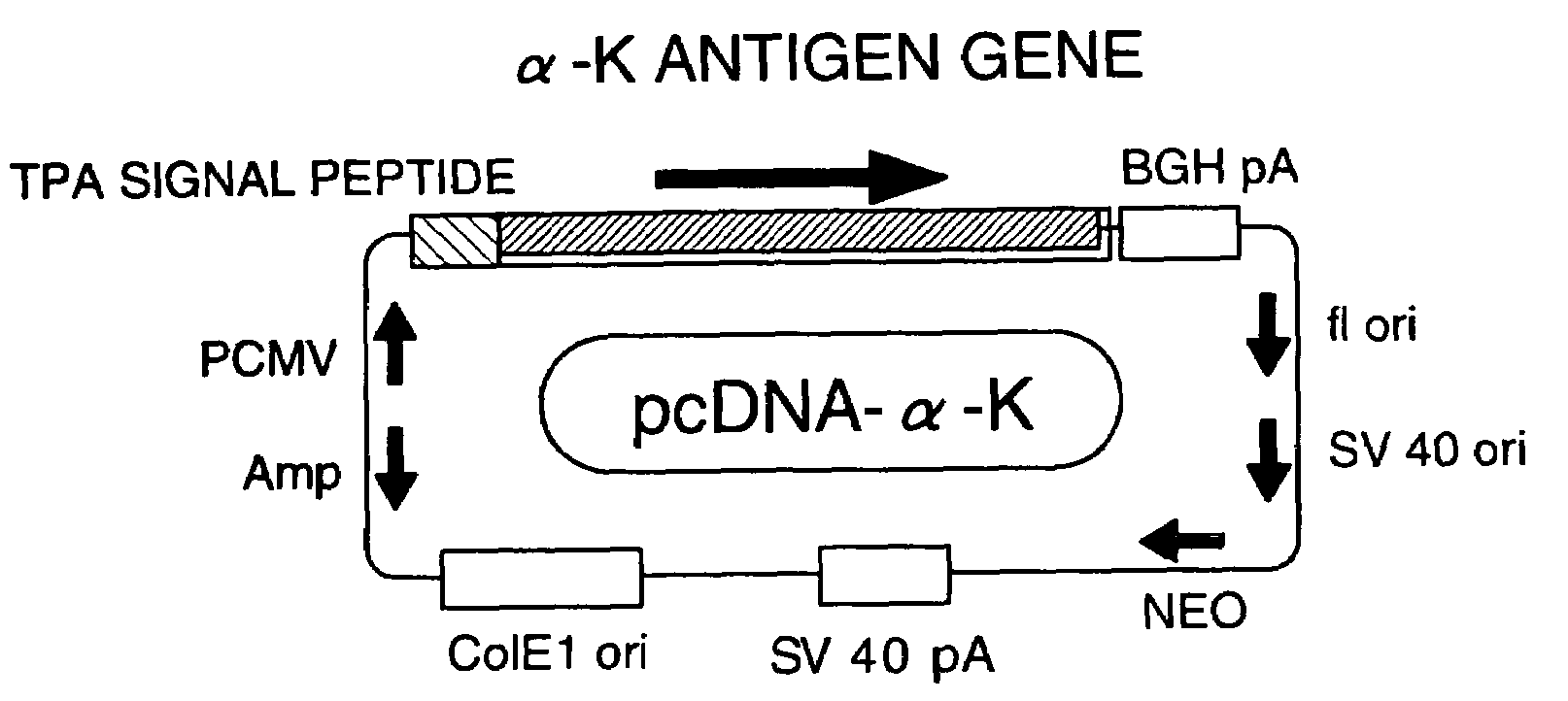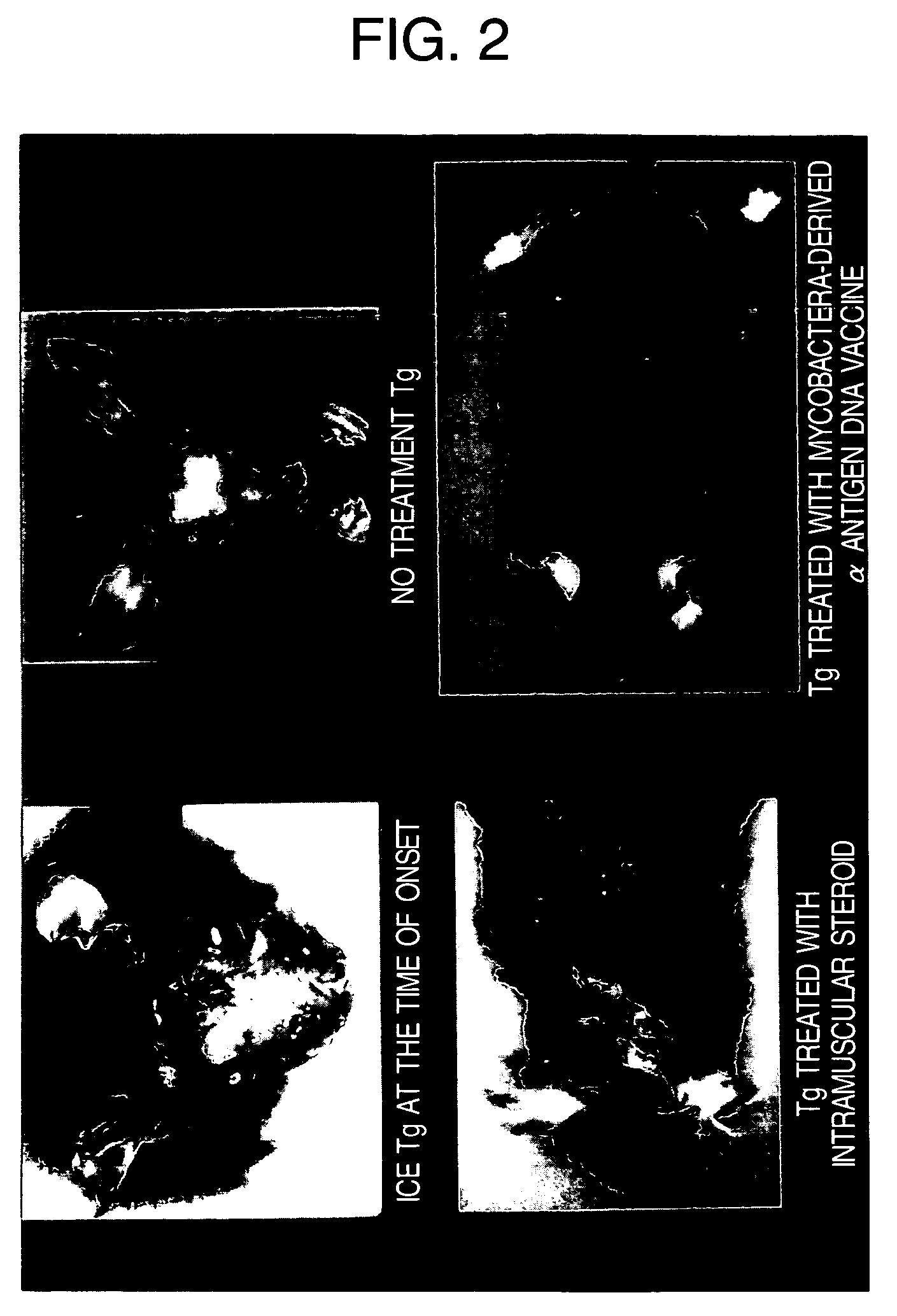Pharmaceutical use of alpha antigen or alpha antigen gene
a technology of alpha antigen and alpha antigen gene, which is applied in the direction of antibody medical ingredients, drug compositions, immunological disorders, etc., can solve the problems of not being subjected to clinical use, not being satisfactory, and small
- Summary
- Abstract
- Description
- Claims
- Application Information
AI Technical Summary
Benefits of technology
Problems solved by technology
Method used
Image
Examples
example 1
Effect of an Expression Vector Containing an α Antigen-Encoding Gene on Atopic Dermatitis
(1) Construction of Expression Vector
[0043]By inserting the α antigen gene (α-K) of Mycobacterium kansasii comprising the base sequence from positions 390-1244 set forth in SEQ ID NO: 1 into the KpnI-ApaI site of pcDNA3.1 (Invitrogen CA), and then integrating it downstream of the CMV promoter and the TPA signal peptide, an expression vector pcDNA-α-K having the construction shown in FIG. 1 was constructed as an active ingredient of a pharmaceutical composition for the treatment of allergic diseases of the present invention (Infect. Immun. 58: 550-556, 1996).
(2) Administration of an Expression Vector to a Mouse Model of Atopic Dermatitis
i) Method
[0044]Transgenic mice (CTg) that express skin-specific Caspase-1 and that are in the Th2-dominant immunological state were used (J. Immunol. 165: 997-1003, 2000; Nat. Immunol. 1: 132-137, 2000; Proc. Nah. Acod. Sci. USA 99;11340-11345, 2002). These mice d...
example 2
Effect of the α Antigen Protein on Atopic Dermatitis
i) Method
[0050]Mycobacterium kansasii was cultured in the Sauton medium for 3 weeks, and the culture supernatant was precipitated with 80% ammonium sulfate to prepare a protein fraction. The protein fraction was developed and separated by two dimensional electrophoresis on the gel, and from the corresponding spot on the gel, α antigen protein was extracted and purified (Scand. J. Immunol. 43: 202-209, 1996; J. Bacteriol. 170: 3847-3854, 1988; Hiroshima J. Med. Sci. 32: 1-8, 1983), and dissolved in PBS at a concentration of 1 mg / ml. One μl each of this α antigen protein solution or the control PBS solution was applied on the head of 4 week old CTg mice (N=3 for each) once daily for one week, and then the condition of hair was visually inspected to asses the effect.
ii) Result
[0051]When the effect was judged by the amount of remaining hair as + (hair growth is seen) or − (no hair growth is seen), hair on the head was scratched away (d...
example 3
Effect of Expression Vector Containing the α Antigen-Encoding Gene on Asthma
1) Method
[0052]BALB / c mice (N=6 for each group) were immunized with intraperitoneally administration of 10 μg of ovalbumin and 1 mg alum on day 0 and day 14 after the start of the experiment. For five days from day 21, the animals were allowed to inhale aerosol of 5% ovalbumin to create an asthma model. The expression vector (100 μg) constructed in Example 1-(I) and the heated BCG dead organism (100 μg) were intraperitoneally administered in equal amounts, respectively, on day 0 and day 14. On day 25 after the start of the experiment, serum levels of IgE, protein concentration in the alveolar lavage, and eosinophil counts were determined for judgement of effect, and furthermore eosinophil infiltration in the lung tissue was examined by an eosinophil staining (Luna stain). Also the lung tissue was histologically examined.
ii) Result
[0053]Serum levels of IgE, protein concentration in the alveolar lavage, eosino...
PUM
 Login to View More
Login to View More Abstract
Description
Claims
Application Information
 Login to View More
Login to View More - R&D
- Intellectual Property
- Life Sciences
- Materials
- Tech Scout
- Unparalleled Data Quality
- Higher Quality Content
- 60% Fewer Hallucinations
Browse by: Latest US Patents, China's latest patents, Technical Efficacy Thesaurus, Application Domain, Technology Topic, Popular Technical Reports.
© 2025 PatSnap. All rights reserved.Legal|Privacy policy|Modern Slavery Act Transparency Statement|Sitemap|About US| Contact US: help@patsnap.com



